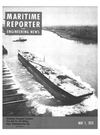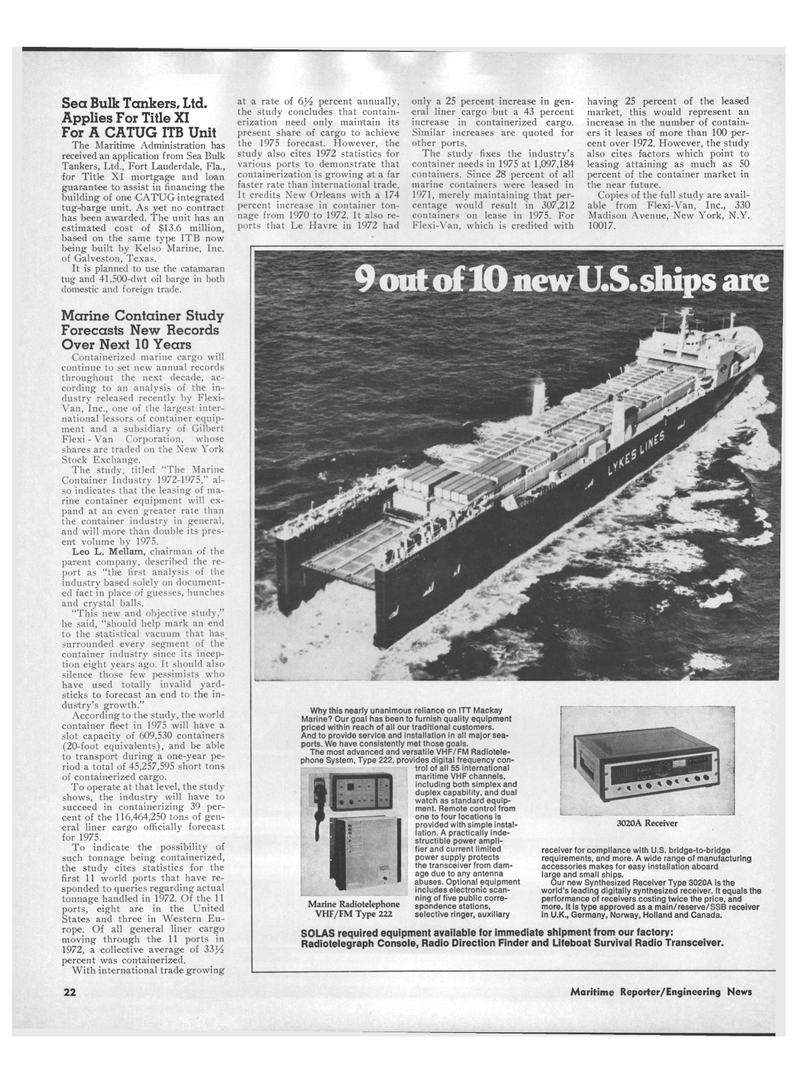
Page 20: of Maritime Reporter Magazine (May 1973)
Read this page in Pdf, Flash or Html5 edition of May 1973 Maritime Reporter Magazine
Sea Bulk Tankers, Ltd.
Applies For Title XI
For A CATUG ITB Unit
The Maritime Administration has received an application from Sea Bulk
Tankers, Ltd., Fort Lauderdale, Fla., for Title XI mortgage and loan guarantee to assist in financing the building of one CATUG integrated tug-barge unit. As yet no contract has been awarded. The unit has an estimated cost of $13.6 million, based on the same type ITB now being built by Kelso Marine, Inc. of Galveston, Texas.
It is planned to use the catamaran tug and 41,500-dwt oil barge in both domestic and foreign trade.
Marine Container Study
Forecasts New Records
Over Next 10 Years
Containerized marine cargo will continue to set new annual records throughout the next decade, ac- cording to an analysis of the in- dustry released recently by Flexi-
Van, Inc., one of the largest inter- national lessors of container equip- ment and a subsidiary of Gilbert
Flexi - Van Corporation, whose shares are traded on the New York
Stock Exchange.
The study, titled "The Marine
Container Industry 1972-1975," al- so indicates that the leasing of ma- rine container equipment will ex- pand at an even greater rate than the container industry in general, and will more than double its pres- ent volume by 1975.
Leo L. Mellam, chairman of the parent company, descril>ed the re- port as "the first analysis of the industry based solely on document- ed fact in place of guesses, hunches and crystal balls. "This new and objective study," lie said, "should help mark an end to the statistical vacuum that has surrounded every segment of the container industry since its incep- tion eight years ago. It should also silence those few pessimists who have used totally invalid yard- sticks to forecast an end to the in- dustry's growth."
According to the study, the world container fleet in 1975 will have a slot capacity of 609,530 containers (20-foot equivalents), and be able to transport during a one-year pe- riod a total of 45,257,595 short tons of containerized cargo.
To operate at that level, the study shows, the industry will have to succeed in containerizing 39 per- cent of the 116,464,250 tons of gen- eral liner cargo officially forecast for 1975.
To indicate the possibility of such tonnage being containerized, the study cites statistics for the first 11 world ports that have re- sponded to queries regarding actual tonnage handled in 1972. Of the 11 ports, eight are in the United
States and three in Western Eu- rope. Of all general liner cargo moving through the 11 ports in 1972, a collective average of 3 percent was containerized.
With international trade growing at a rate of 6^ percent annually, the study concludes that contain- erization need only maintain its present share of cargo to achieve the 1975 forecast. However, the study also cites 1972 statistics for various ports to demonstrate that containerization is growing at a far faster rate than international trade.
It credits New Orleans with a 174 percent increase in container ton- nage from 1970 to 1972. It also re- ports that Le Havre in 1972 had only a 25 percent increase in gen- eral liner cargo but a 43 percent increase in containerized cargo.
Similar increases are quoted for other ports.
The study fixes the industry's container needs in 1975 at 1,097,184 containers. Since 28 percent of all marine containers were leased in 1971, merely maintaining that per- centage would result in 307,212 containers on lease in 1975. For
Flexi-Van, which is credited with having 25 percent of the leased market, this would represent an increase in the number of contain- ers it leases of more than 100 per- cent over 1972. However, the study also cites factors which point to leasing attaining as much as 50 percent of the container market in the near future.
Copies of the full study are avail- able from Flexi-Van, Inc., 330
Madison Avenue, New York, N.Y. 10017.
Why this nearly unanimous reliance on ITT Mackay
Marine? Our goal has been to furnish quality equipment priced within reach of all our traditional customers.
And to provide service and installation in all major sea- ports. We have consistently met those goals.
The most advanced and versatile VHF/FM Radiotele- phone System, Type 222, provides digital frequency con- trol of all 55 international maritime VHF channels, including both simplex and duplex capability, and dual watch as standard equip- ment. Remote control from one to four locations is provided with simple instal- lation. A practically inde- structible power ampli- fier and current limited power supply protects the transceiver from dam- age due to any antenna abuses. Optional equipment includes electronic scan- ning of five public corre- spondence stations, selective ringer, auxiliary
Marine Radiotelephone
VHF/FM Type 222 3020A Receiver receiver for compliance with U.S. bridge-to-bridge requirements, and more. A wide range of manufacturing accessories makes for easy installation aboard large and small ships.
Our new Synthesized Receiver Type 3020A is the world's leading digitally synthesized receiver. It equals the performance of receivers costing twice the price, and more. It is type approved as a main/reserve/SSB receiver in U.K., Germany, Norway, Holland and Canada.
SOLAS required equipment available for immediate shipment from our factory:
Radiotelegraph Console, Radio Direction Finder and Lifeboat Survival Radio Transceiver. 9 oat of 10 new U.S. ships are 22 Maritime Reporter/Engineering News

 19
19

 21
21
